Page 36 of 420

Together, airbags and
seat belts provide the best
protection.
Tampering could cause
the airbags to deploy, possibly
causing very serious injury. This could make the
driver’s seat position sensor or the
f ront passenger’s weight sensors
inef f ective. If it is necessary to
remove or modif y a f ront seat to
accommodate a person with
disabilities, f irst contact American
Honda at 800-999-1009.
Improperly replacing
or covering f ront seat-back covers
can prevent your side airbags f rom
inf lating during a side impact.
If water or
another liquid soaks into the seat-
back, it can prevent the side airbag
cutof f system f rom working
properly.
Additional Saf ety Precautions
Donotattempttodeactivateyour
airbags.
Do not t amper wit h airbagcomponent s or wiring f or anyreason. Do not remove or modif y a f ront
seat without consulting yourdealer.
Do not cover or replace f ront seat -back covers wit hout consult ingyour dealer.
Do not expose the f ront passenger’s
seat-back to liquid.
Additional Inf ormation About Your Airbags
Driver and Passenger Saf ety
35
Page 38 of 420
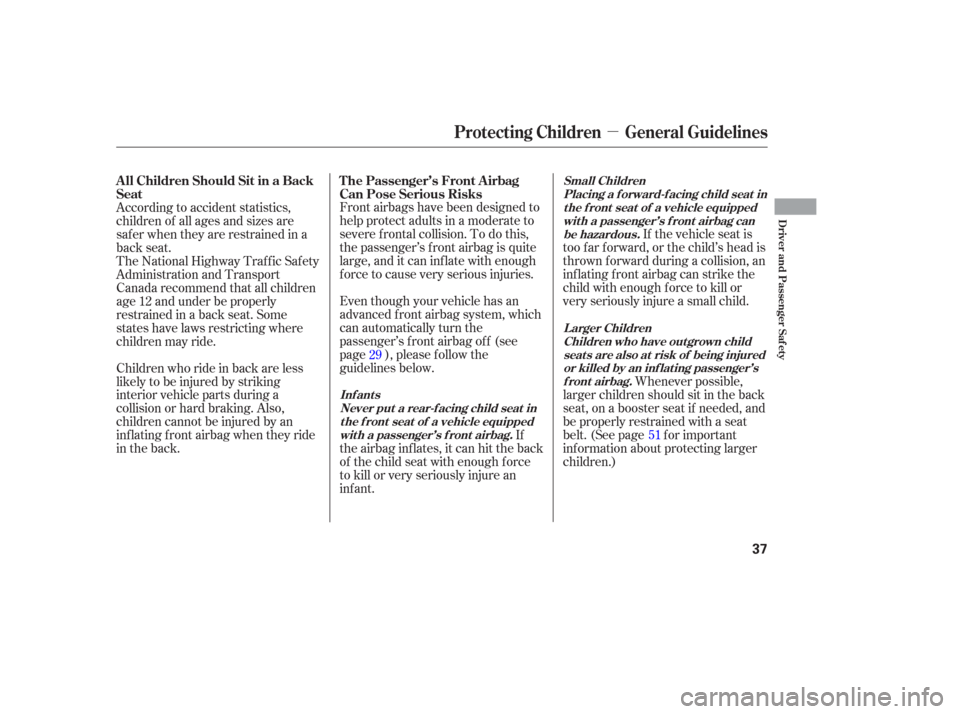
�µ
Front airbags have been designed to
help protect adults in a moderate to
severe f rontal collision. To do this,
the passenger’s f ront airbag is quite
large, and it can inflate with enough
f orce to cause very serious injuries.
Even though your vehicle has an
advanced front airbag system, which
can automatically turn the
passenger’s front airbag off (see
page ), please f ollow the
guidelines below.If
the airbag inf lates, it can hit the back
of the child seat with enough force
to kill or very seriously injure an
inf ant. If the vehicle seat is
too far forward, or the child’s head is
thrown f orward during a collision, an
inflating front airbag can strike the
child with enough f orce to kill or
very seriously injure a small child.
Whenever possible,
larger children should sit in the back
seat, on a booster seat if needed, and
be properly restrained with a seat
belt. (See page f or important
inf ormation about protecting larger
children.)
According to accident statistics,
children of all ages and sizes are
saf er when they are restrained in a
back seat.
The National Highway Traffic Safety
Administration and Transport
Canada recommend that all children
age 12 and under be properly
restrained in a back seat. Some
states have laws restricting where
children may ride.
Children who ride in back are less
likely to be injured by striking
interior vehicle parts during a
collision or hard braking. Also,
children cannot be injured by an
inflating front airbag when they ride
in the back.
51
29
The Passenger’s Front Airbag
Can Pose Serious Risks
All Children Should Sit in a Back
Seat
Inf ant s
Never put a rear-f acing child seat inthe f ront seat of a vehicle equippedwit h a passenger’s f ront airbag. Small Children
Placing a f orward-f acing child seat inthe f ront seat of a vehicle equippedwit h a passenger’s f ront airbag canbe hazardous.
Larger ChildrenChildren who have outgrown childseat s are also at risk of being injuredor killed by an inf lat ing passenger’sfront airbag.
Protecting Children General Guidelines
Driver and Passenger Saf ety
37
Page 39 of 420
�µ
To remind you of the passenger’s
f ront airbag hazards, and that
children must be properly restrained
in a back seat, your vehicle has
warninglabelsonthedashboard
(U.S. models) and on the driver’s and
f ront passenger’s visors. Please read
and f ollow the instructions on these
labels.Canadian Models
U.S. Models
Protecting Children General Guidelines
38
Page 40 of 420
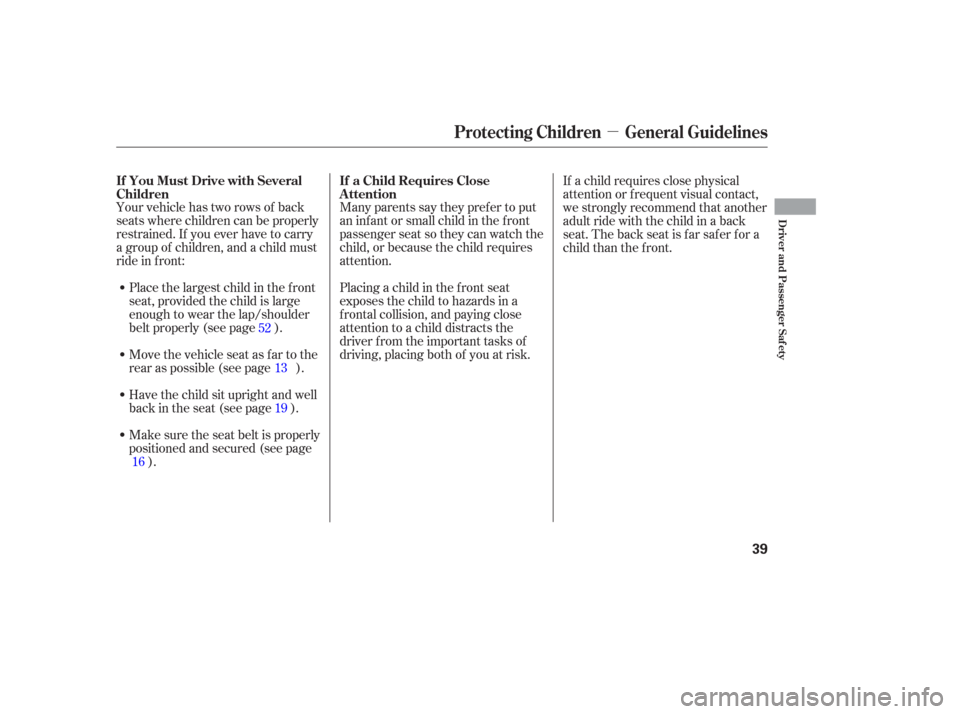
�µ
Your vehicle has two rows of back
seats where children can be properly
restrained. If you ever have to carry
a group of children, and a child must
ride in f ront:Many parents say they pref er to put
an inf ant or small child in the f ront
passenger seat so they can watch the
child, or because the child requires
attention.
Placing a child in the f ront seat
exposes the child to hazards in a
f rontal collision, and paying close
attention to a child distracts the
driver from the important tasks of
driving, placing both of you at risk.
Place the largest child in the f ront
seat, provided the child is large
enough to wear the lap/shoulder
belt properly (see page ).
Move the vehicle seat as far to the
rear as possible (see page ).
Have the child sit upright and well
backintheseat(seepage ).
Make sure the seat belt is properly
positioned and secured (see page
). If a child requires close physical
attention or f requent visual contact,
we strongly recommend that another
adult ride with the child in a back
seat. The back seat is far safer for a
child than the front.
52 13
19
16
If You Must Drive with Several
Children
If a Child Requires Close
Attention
Protecting Children General Guidelines
Driver and Passenger Saf ety
39
Page 41 of 420
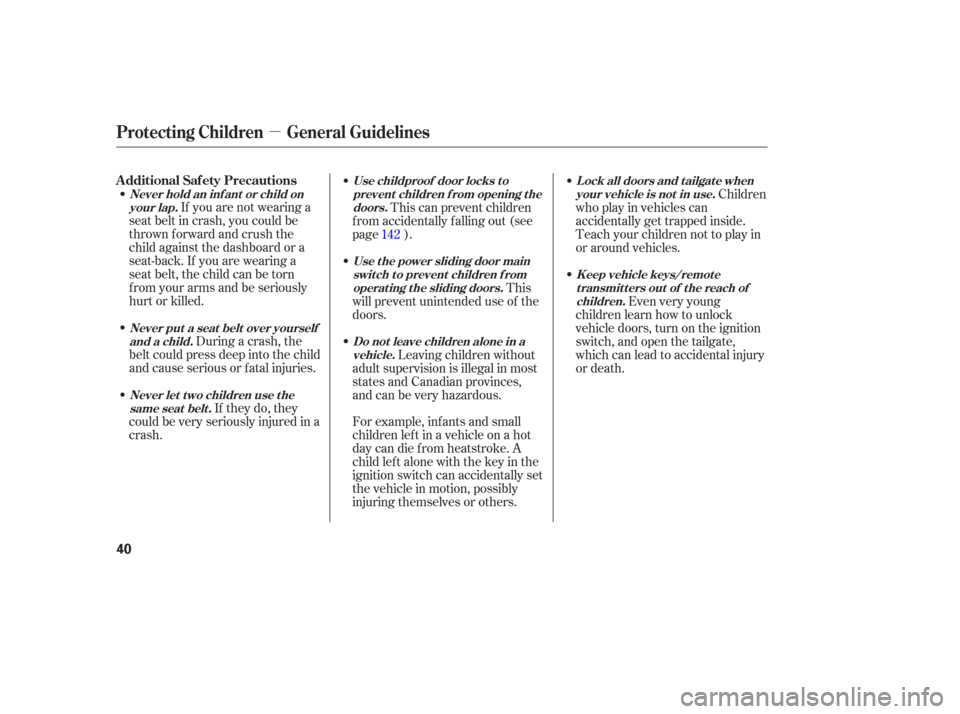
�µ
During a crash, the
belt could press deep into the child
and cause serious or fatal injuries.
If they do, they
could be very seriously injured in a
crash. If you are not wearing a
seat belt in crash, you could be
thrown forward and crush the
child against the dashboard or a
seat-back. If you are wearing a
seat belt, the child can be torn
from your arms and be seriously
hurt or killed. This can prevent children
f rom accidentally f alling out (see
page ).
For example, infants and small
childrenleftinavehicleonahot
day can die f rom heatstroke. A
child lef t alone with the key in the
ignition switch can accidentally set
the vehicle in motion, possibly
injuring themselves or others. Children
who play in vehicles can
accidentally get trapped inside.
Teach your children not to play in
or around vehicles.
Even very young
children learn how to unlock
vehicle doors, turn on the ignition
switch, and open the tailgate,
which can lead to accidental injury
or death.
Leaving children without
adult supervision is illegal in most
states and Canadian provinces,
and can be very hazardous. This
will prevent unintended use of the
doors. 142
Never put a seat belt over yourself
and a child.
Never let two children use thesame seat belt .
Neverholdaninfantorchildon
your lap. Use childproof door locks t o
prevent children f rom opening t hedoors. L ock all doors and t ailgat e when
your vehicle is not in use.
K eep vehicle keys/remot etransmitters out of the reach ofchildren.
Do not leave children alone in a vehicle.
Use t he power sliding door main
swit ch t o prevent children f romoperat ing t he sliding doors.
Additional Saf ety Precautions
Protecting Children General Guidelines
40
Page 42 of 420
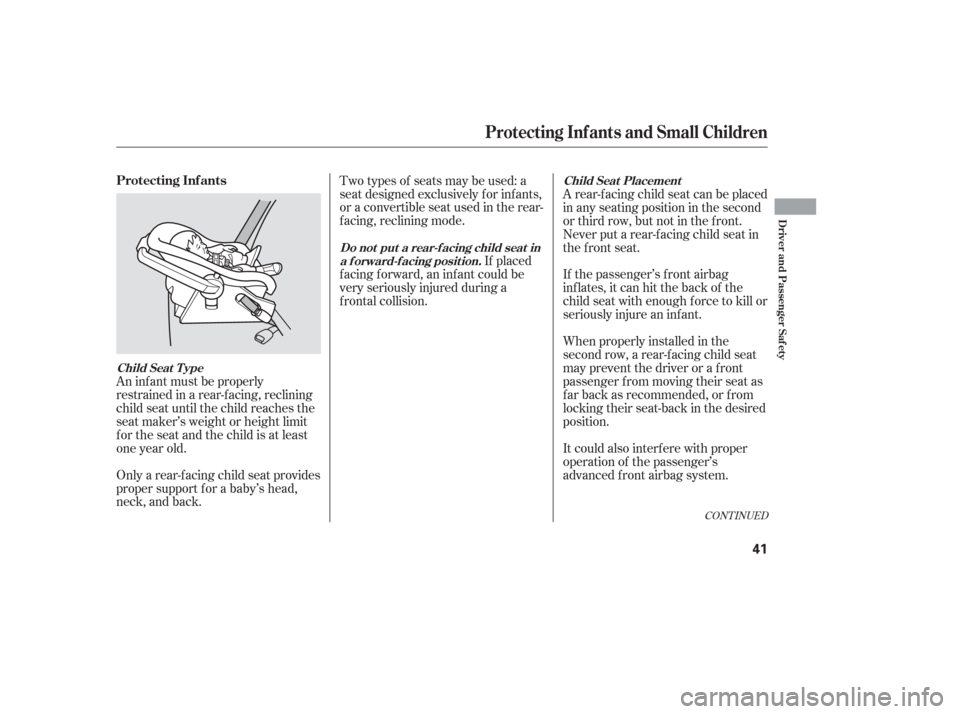
An inf ant must be properly
restrained in a rear-f acing, reclining
child seat until the child reaches the
seat maker’s weight or height limit
for the seat and the child is at least
one year old.
Only a rear-f acing child seat provides
proper support f or a baby’s head,
neck, and back.Two types of seats may be used: a
seat designed exclusively f or inf ants,
or a convertible seat used in the rear-
f acing, reclining mode.
If placed
f acing f orward, an inf ant could be
very seriously injured during a
f rontal collision. If the passenger’s front airbag
inflates, it can hit the back of the
child seat with enough f orce to kill or
seriously injure an inf ant. A rear-f acing child seat can be placed
in any seating position in the second
or third row, but not in the f ront.
Never put a rear-f acing child seat in
the front seat.
When properly installed in the
second row, a rear-f acing child seat
maypreventthedriverorafront
passenger f rom moving their seat as
f ar back as recommended, or f rom
locking their seat-back in the desired
position.
It could also interf ere with proper
operation of the passenger’s
advanced front airbag system.
CONT INUED
Protecting Inf ants
Child Seat T ype Child Seat Placement
Do not put a rear-f acing child seat in a f orward-f acing position.
Protecting Inf ants and Small Children
Driver and Passenger Saf ety
41
Page 43 of 420
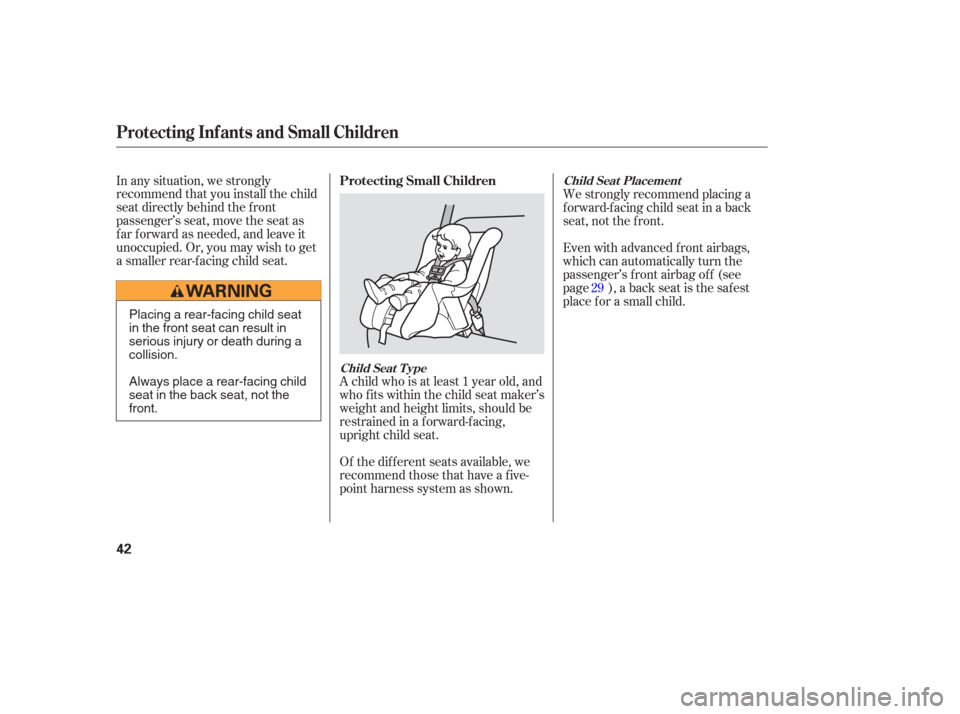
Of the different seats available, we
recommend those that have a f ive-
point harness system as shown.
In any situation, we strongly
recommend that you install the child
seat directly behind the f ront
passenger’s seat, move the seat as
f ar f orward as needed, and leave it
unoccupied. Or, you may wish to get
a smaller rear-f acing child seat.
A child who is at least 1 year old, and
who f its within the child seat maker’s
weight and height limits, should be
restrained in a f orward-f acing,
upright child seat.We strongly recommend placing a
forward-facing child seat in a back
seat, not the f ront.
Even with advanced front airbags,
which can automatically turn the
passenger’s front airbag off (see
page ), a back seat is the saf est
place f or a small child.
29
Protecting Small Children
Child Seat T ype Child Seat Placement
Protecting Inf ants and Small Children
42
Placing a rear-facing child seat
in the front seat can result in
serious injury or death during a
collision.
Always place a rear-facing child
seat in the back seat, not the
front.
Page 44 of 420
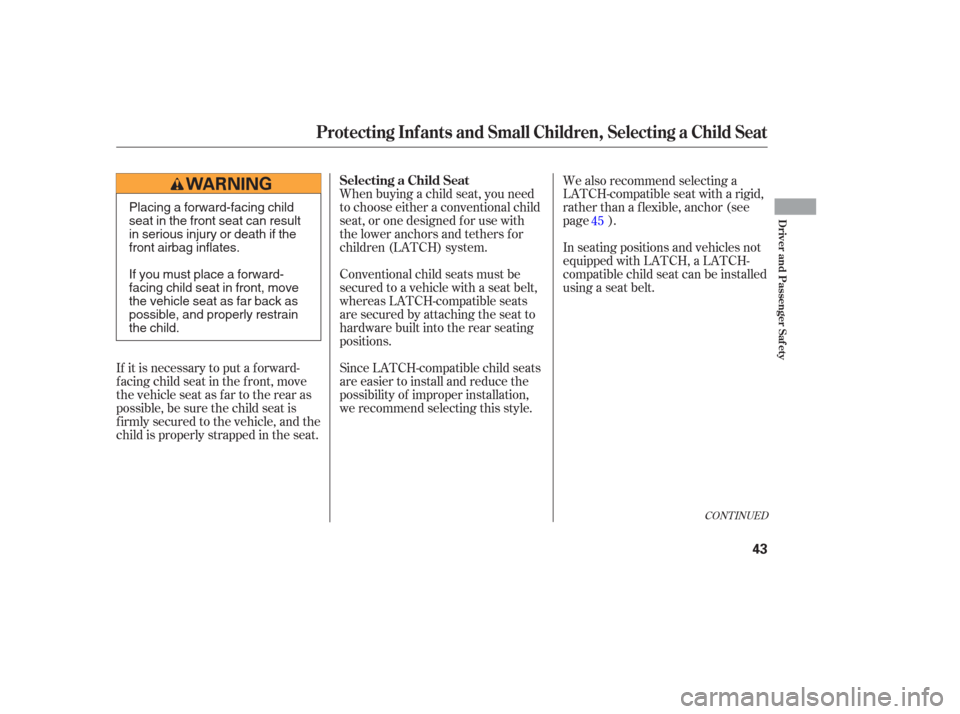
When buying a child seat, you need
to choose either a conventional child
seat, or one designed f or use with
the lower anchors and tethers for
children (LATCH) system.In seating positions and vehicles not
equipped with LATCH, a LATCH-
compatible child seat can be installed
using a seat belt. We also recommend selecting a
LATCH-compatible seat with a rigid,
rather than a f lexible, anchor (see
page ).
Conventional child seats must be
secured to a vehicle with a seat belt,
whereas LATCH-compatible seats
are secured by attaching the seat to
hardware built into the rear seating
positions.
Since LATCH-compatible child seats
are easier to install and reduce the
possibility of improper installation,
we recommend selecting this style.
If it is necessary to put a f orward-
f acing child seat in the f ront, move
the vehicle seat as far to the rear as
possible, be sure the child seat is
f irmly secured to the vehicle, and the
child is properly strapped in the seat. 45
CONT INUED
Selecting a Child Seat
Protecting Inf ants and Small Children, Selecting a Child Seat
Driver and Passenger Saf ety
43
Placing a forward-facing child
seat in the front seat can result
in serious injury or death if the
front airbag inflates.
Ifyoumustplaceaforward-
facing child seat in front, move
the vehicle seat as far back as
possible, and properly restrain
the child.